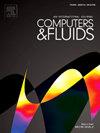A data-driven actuator-line methodology for the simulation of high-lift aircraft wake systems
IF 2.5
3区 工程技术
Q3 COMPUTER SCIENCE, INTERDISCIPLINARY APPLICATIONS
引用次数: 0
Abstract
The actuator-line method is here integrated with a data-driven approach for the investigation of aircraft-induced trailing vortices as generated by landing and take-off configurations with varying levels of high-lift device deflections. It is shown that through coupling the Actuator-Line-Method to a suitable Reduced-Order-Model built upon spanwise aerodynamic force distributions obtained from high-fidelity CFD solution data. The resulting wake from the geometry can be reproduced in a manner that no longer requires an explicit representation of the aircraft geometry within the simulation environment. The result is a method that allows for increased fidelity in the vortex farfield when studying the relevant wake dynamics and evolution during take-off, climb, approach and landing. The accuracy of the proposed method is assessed via a direct comparison to traditional high-fidelity nearfield derived results where it was observed that the induced downstream velocity profile and resulting location of vortex structures displayed a satisfactory level of agreement. With the creation of such a method, the effects of variations in aircraft high-lift deployment can be included within the simulation of downstream vortex pairs in a manner that respects the computational limitations of current hardware.
求助全文
约1分钟内获得全文
求助全文
来源期刊

Computers & Fluids
物理-计算机:跨学科应用
CiteScore
5.30
自引率
7.10%
发文量
242
审稿时长
10.8 months
期刊介绍:
Computers & Fluids is multidisciplinary. The term ''fluid'' is interpreted in the broadest sense. Hydro- and aerodynamics, high-speed and physical gas dynamics, turbulence and flow stability, multiphase flow, rheology, tribology and fluid-structure interaction are all of interest, provided that computer technique plays a significant role in the associated studies or design methodology.
 求助内容:
求助内容: 应助结果提醒方式:
应助结果提醒方式:


